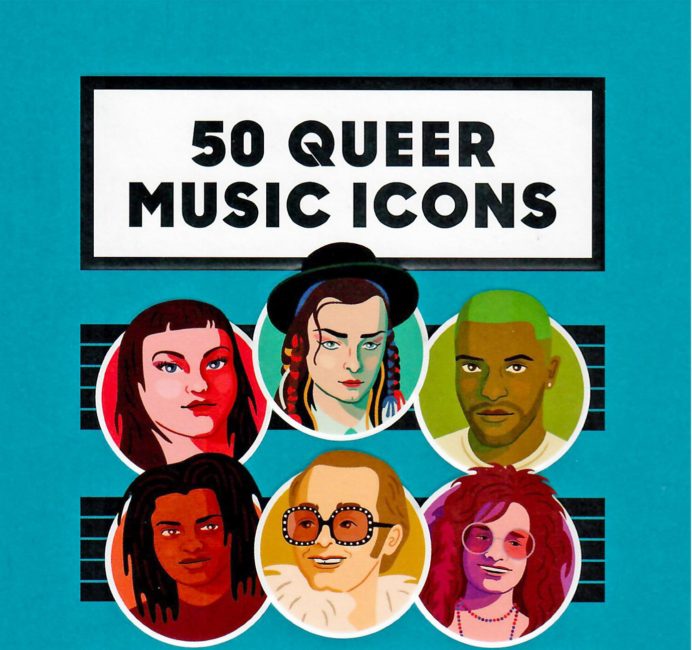
50 Queer Music Icons Who Changed the World takes fifty icons across one hundred years to demonstrate how those from the LGBT community and/or icons who endorsed and aided the LGBT community impacted the music scene. Each musician has a page of text and an impressive info-graphic style illustration of them. There is no organised order as to the way the artists are presented throughout this book. For instance, the artists are not arranged either in chronological, influential or alphabetical order.
Whilst the author offers no obvious categorisation, the artists included can be categorised into the following: household globally acclaimed artists; classic and early to mid-twentieth century artists, new artists (the year 2000 onwards) and unexpected LGBT icons, making a deft, relevant and complete set of LGBT icons. Furthermore, virtually every music genre is covered.
The majority of 50 Queer Music Icons cover household globally acclaimed artists. Shedding new interesting light on these figures such as Boy George, Freddie Mercury and David Bowie must have been a challenging task. However, at no point does the reader come across readily available old or recycled facts and news. For example, we learn that there are more LGBT influential songs by Diana Ross than “I’m Coming Out”. Whilst much has been said about Elton John being a Watford FC fan and growing up in nearby Pinner; Elton is actually an “Essex boy”. Andy Bell (Erasure) has had two hip replacements and the 1979 Village People song “In the Navy” was at the time considered for use as an advert in U.S. Navy recruitment despite there being an LGBT ban in the American military which wasn’t lifted until 1993.
The number of new and influential artists included is impressive and positive such as The XX, female rapper Mykki Blanco, Beth Ditto (The Gossip), Troye Sivan, Anohni (Antony and the Johnsons), John Grant and Frank Ocean who is represented as one of the most influential rappers on “The Tens Card Game” (reviewed by XS Noize). It was genuinely as interesting and insightful to read about these artists as it was to read about the artists in the previous paragraph.
There are some artists whose LGBT connection will for many be unknown and this book will, therefore, be an elating learning curve. This list which includes Jónsi (Sigur Rós), Frankie Knuckles (the “Godfather of House music”) who received the first Grammy in the category of Best Remixed Recording. When Barack Obama was a senator, he named 25th August Frankie Knuckles day in Chicago. Jo Briath, although initially known more for being one of the first pop stars to die from aids in 1983; his talent and legacy are championed by artists such as Marc Almond and Morrissey. Other unassuming artists include Rob Halford (Judas Priest) and Linda Perry (4 Non-Blondes) who as well as being an artist in her own right is also the producer of many acclaimed hits including Christina Aguilera’s “Beautiful”.
Whilst the former paragraph focuses on unexpected LGBT icons; the classic and early to mid-twentieth century icons is probably the most important as it demonstrates that LGBT characteristics and identity are not a modern phenomenon but have been present since time immemorial. Artists include Little Richard, Liberace and Ma Rainey (the “Mother of the Blues”) whose songs from the 1920’s” directly referenced her sexuality”. Other equally pivotal figures include Willie Mae Thornton who made the original version of “Hound Dog” in 1952 shifting two million copies three years before Elvis Presley released his version. Who wrote “the world’s first gay protest song”? This and many other important LGBT influences are revealed across 50 Queer Music Icons too.
From the music buff (whether they have a perchance for LGBT issues or not) or the LGBT advocate with a primary focus on LGBT matters; all will come away enriched and more knowledgeable about both subjects. The problem with including just fifty artists is that fifty artists could never be enough to demonstrate the complete spectrum of LGBT influences and icons. However, Will Larnach-Jones addresses this by suggesting eighteen other artists such as rapper Le1f, Marc Almond and Dusty Springfield who also could have been included. Nonetheless, it is difficult to intellectualise how a better selection could have been chosen.
To find out more and own your own copy please visit here.


Be the first to comment